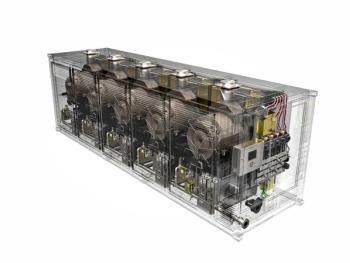
COMPRESSOR PRESERVATION
THE LONG-TERM PRESERVATION OF COMPRESSORS
By Pietro Emanuele Galanti and Fabrizio Mogavero
Figure 1: All connections must be be flanged (highlighted in green)
Should the compressor be shipped with the dry gas seal (DGS) installed or not? This question must be answered during the execution phase of a project. Experience has demonstrated that by setting an adequate long-term preservation procedure, it is possible to ship the equipment with dry gas seals installed. This approach makes it possible to achieve a compromise between commercial savings and machinery protection.
The following procedure has been proven to preserve the compressor condition with the dry gas seals installed. Some vendors already follow this procedure during the engineering phase.
This system is the same as that applied to the long-term preservation of the compressor spare rotor using a nitrogen-pressurized container. In this case, the compressor casing is used as a container for the protection of its internal parts.
These actions should be done on site in this order. First, the compressor should be uncoupled from the driver. All connections must be flanged (Figure 1). As a further precaution, flanges should be taped around the circumference to ensure weather-tight sealing. Next, wash the compressor and pressurize it with nitrogen. The pressure must be maintained a little above atmospheric by means of a pressurization system (Figure 2).
Figure 2: Pressure must be maintained a little above atmospheric pressure by means of a pressurization system as below picture (highlighted in light blue)
Before commencing compressor preservation, tests should be done on the pressurization system by plugging the line upstream to the seal connection (Figure 2, item 2) and closing the end valve (Figure 2, item 3). Open the nitrogen cylinder valve, gradually increase the pressure to its maximum setting (about 50-60 mbar), close the cylinder valve, wait about 30 minutes and record the pressure. After 24 hours, check and note the pressure. If there is no variation, the system can be depressurized, unplugged and made ready for the pressurized test of the compressor.
After connecting the system to the compressor, open the nitrogen cylinder valve, check that the pressure reducer in the cylinder is correctly set, and, if necessary, adjust it. Also verify that the pressure-reducing valve is properly set to close the nitrogen-cylinder valve.
Following a successful pressurization check, proceed with nitrogen purging using an external nitrogen source to eliminate humidity inside the compressor. This is accomplished by closing the nitrogen cylinder valve and using the connection upstream of the valve (Figure 2, item 3) to connect the external source of nitrogen.
Open the valves installed on the compressor’s self-buffering connection and vents ( Figure 2, item 4). Adjust the valve (Figure2, item 3) to achieve about 50-60 mbar of pressure. Wait for nitrogen purging, then close the valve (item 3). After that, close the valve on the self-buffering connection and vents (item 4) to maintain an internal pressure of around 15-20 mbar. Disconnect the external nitrogen source from the valve (item 3). After purging is complete, start the pressurization system by opening the nitrogen cylinder valve.
When conducting these preservation procedures on site, it is important to periodically check the pressure of the nitrogen cylinder. It is advisable to change the cylinder if the pressure sinks below about 20-30 mbar.
One advantage of installing the DGS in the factory is that it reduces the amount of onsite activity. The estimation of time required for one compressor is about 200-250 hours. In addition, thermoelements, radial probes, axial probes and o-rings can avoid damage during compressor disassembly.
On the downside, nitrogen is consumed. As a rough estimate, one average-sized compressor needs about 1.5 m3 of nitrogen for each wash performed. Correctly applied, this approach permits use of the compressor casing as a pressurized container for nitrogen preservation.
This method facilitates shipping the compressor with the dry gas seal installed, and reduces overall costs of onsite installation. In addition, early leakage testing of the compressor eliminates the possibility of leaks after compressor start-up due to incorrect DGS installation on-site.
Authors: Pietro Emanuele Galanti and Fabrizio Mogavero represent Saipem, an Italian oil and gas industry contractor. It is a subsidiary of Italian energy company Eni. For more information, visit saipem.com
Newsletter
Power your knowledge with the latest in turbine technology, engineering advances, and energy solutions—subscribe to Turbomachinery International today.




